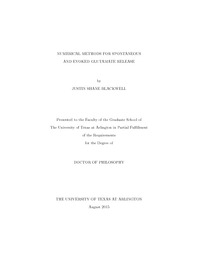
ATTENTION: The works hosted here are being migrated to a new repository that will consolidate resources, improve discoverability, and better show UTA's research impact on the global community. We will update authors as the migration progresses. Please see MavMatrix for more information.
Show simple item record
| dc.contributor.author | Blackwell, Justin Shane | en_US |
| dc.date.accessioned | 2015-12-11T23:20:12Z | |
| dc.date.available | 2015-12-11T23:20:12Z | |
| dc.date.submitted | January 2015 | en_US |
| dc.identifier.other | DISS-13357 | en_US |
| dc.identifier.uri | http://hdl.handle.net/10106/25407 | |
| dc.description.abstract | As synapses are responsible for the majority of neuron communications in the brain, the events of evoked and spontaneous synaptic vesicle release/fusion are key features of all synaptic current. These release events typically activate receptors within a single postsynaptic site and give rise to miniature postsynaptic currents through activations of $N$-methyl-$D$-asparate (NMDA) and $\alpha$-3-hydroxy-5-methyl-4-isoxazolepropionic acid (AMPA) receptors, and therefore, they have been extremely instrumental in neurotransmissions. In this paper we will use a mathematical model to simulate spontaneous and evoked neurotransmission resulted from glutamate release within a synapse. Among several issues that modeling can provide quantitative assessment, the issue of independent signaling of spontaneous and evoked neurotransmission has been prominent. Our main goal is to determine the necessary conditions synapses to obtain independent signaling. We examine how different factors, including the release rate of the neurotransmitter, size and geometry of synaptic cleft, and diffusion coefficient will affect post-synaptic currents and which of these are instrumental in obtaining independent signaling. | en_US |
| dc.description.sponsorship | Su, Jianzhong | en_US |
| dc.language.iso | en | en_US |
| dc.publisher | Mathematics | en_US |
| dc.title | Numerical Methods For Spontaneous And Evoked Glutamate Release | en_US |
| dc.type | Ph.D. | en_US |
| dc.contributor.committeeChair | Su, Jianzhong | en_US |
| dc.degree.department | Mathematics | en_US |
| dc.degree.discipline | Mathematics | en_US |
| dc.degree.grantor | University of Texas at Arlington | en_US |
| dc.degree.level | doctoral | en_US |
| dc.degree.name | Ph.D. | en_US |
Files in this item
- Name:
- Blackwell_uta_2502D_13357.pdf
- Size:
- 1.995Mb
- Format:
- PDF
This item appears in the following Collection(s)
Show simple item record


